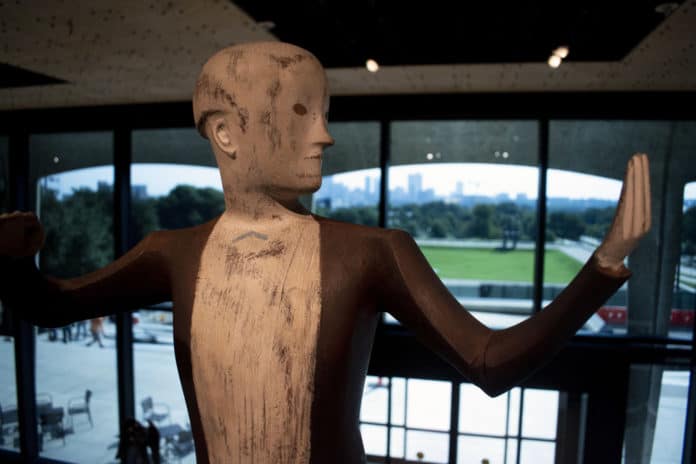Amon Carter Museum of American Art
3501 Camp Bowie Blvd.
Fort Worth 76107
www.cartermuseum.org
The motorized, dark but translucent shades roll up slowly to reveal Fort Worth skyline in the distance through a tall, clear glass window.
Slinking in through the window is the morning sunlight, gently striking the walls, floors and several artworks – some hanging, some floating and some just enduring the taste of time.
This space is part of a large gallery now installed at the front lobby of the newly renovated Amon Carter Museum of American Art.
Artistic?
Yes. The glass wall creates the image that the gallery faces and is in a perpetual conversation with the city.
After a year-long renovation project, which required a three-month closure, the museum is set to reopen.
The museum now features newer technology, lighting and sleeker designs for presenting artworks and artifacts.
The museum building and galleries feature a new layout that provides an improved experience for visitors while preserving the vision and legacy of founder Amon G. Carter Sr. and his daughter Ruth Carter Stevenson
The Sept. 14 grand reopening celebration begins at 10 a.m. with daylong events during the annual Party on the Porch featuring live music, food trucks, and cash bars.
The museum is offering members-only preview days from early September through Sept. 13.
Walking into the museum from its main entrance, one cannot help but think this is a brand-new facility. But, the significance of the history and information inside the almost-six-decade-old museum is still intact.
“Connecting past and present is an important part of what we do,” said Brett Abbott, the museum’s director of collections and exhibitions. “And, that’s an important part of this renovation and reinstallation.”
To improve visitors’ experience, the renovation project developed new layouts throughout the building and individual galleries.
Alongside the physical process of renewing and adding new galleries, upgrades to floorings, ceilings and wall configurations were also made. The galleries and viewing space for artworks are more open and welcoming to accommodate larger visitor flow.
The museum has reorganized the artworks to showcase themes, ideas and to tell stories behind each of them, Abbott said.
And the focus has also shifted toward making the museum more technologically adept.
According to research conducted by the American Academy of Arts and Sciences, young Americans (ages 18 to 44) are visiting museums at an increasing rate, 15% or greater, since 2012.
Abbott believes bringing in technology can garner even more interest from younger audiences, most of whom have a pronounced digital life and are looking for “Instagramable” moments that could be found inside an art museum.
“Technology and infrastructure was a big part of the renovation side of this,” Abbott said. “We’ve layered the gallery with power in the floors, with data on the floors, with a new WiFi system that will allow us to do educational interpretive components on people’s phone as they walk through the galleries.”
Hardwood flooring has replaced old floor and new LED lights evoke daylight in exhibitions. A modular wall system now makes it possible to easily and efficiently bring new exhibitions to the museum.
The added technological components are designed to be hidden.
Sticking with the theme of advanced technology, the museum is introducing digital interactive artwork as well.
Internationally acclaimed artist Camille Utterback’s Untitled 5 is in view at the museum till Dec. 8. The artwork translates visitors’ movements into an animated digital painting through computer software written by the artist.
“[The renovation has] allowed the works of art to speak differently to each other,” Carter Museum’s executive director Andrew J. Walker said. But it also speaks, he said, to the museum’s responsibility to history and relationship to issues and creativity that happens today.
The museum has expanded its photography vaults to allow for future collection growth and preservation of current holdings in a climate-controlled environment.
The early photographic works of Gordon Parks, the first African-American staff photographer at Life magazine, is also displayed at the Carter Museum. Gordon Parks: The New Tide, Early Work 1940-1950, is the renovated museum’s inaugural exhibition, organized by the National Gallery of Art and nationally sponsored by Bank of America.
The Carter Museum also established the Gentling Study Center, in honor and to enhance the recognition of Fort Worth artists Scott and Stuart Gentling.
Many of the Gentlings’ finest works are housed in the center’s study room. The museum plans to add more and build a repository dedicated to the artists.
“This is one of the greatest assets not only in Fort Worth, not only in the region but in many respects, in the relationship to American art and the American experience,” Walker said. “We have it right here in Fort Worth – one of the deepest and most significant collections of American art.”
The building was built to house Texas icon Amon G. Carter’s collection of artworks by artists Charles M. Russell and Frederic Remington.
Housed in a building designed by Philip Johnson (1906–2005), the Carter features one of the great collections of American art including masterworks of painting, sculpture, and works on paper by artists such as Georgia O’Keeffe, Jacob Lawrence, John Singer Sargent, Frederic Church, Thomas Eakins, Grant Wood, Alexander Calder and Stuart Davis.
The Carter is also home to a world-renowned photography collection that spans the history of the medium from the 19th century to today.
By 1967, the museum’s founding director, Mitchell Wilder, brought in a curator from New York. Together, they staged an American art exhibition.
Soon, Wilder expanded the museum’s collecting policy to include American art of the 19th and early 20th centuries.
“Reaping the rewards of that vision, you see hanging here … [are] milestones in the history of American art,” said curator Shirley Reece-Hughes. “Not only iconic subject matter from landscapes to cityscapes but also significant guidepost in the artist’s career.”
The renovation project now hopes to usher in a new age and expand that image for the Amon Carter Museum even further.






